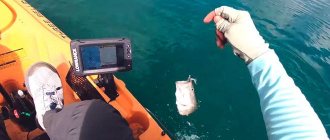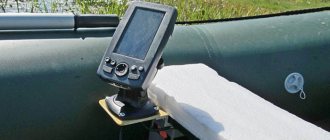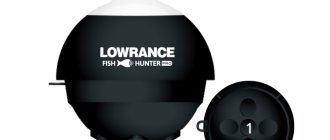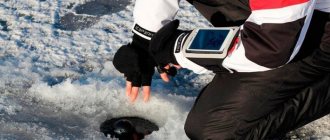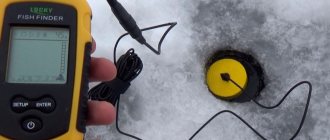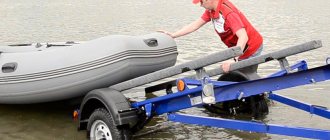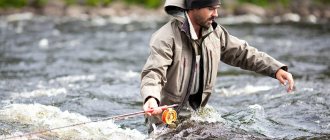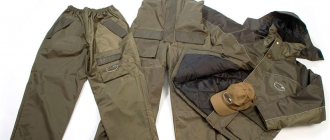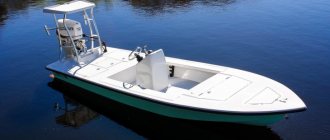Operating principle
An echo sounder for fishing is capable of recognizing the bottom topography and objects under water using sound waves of a certain frequency, using the components included in its composition. The average device consists of four main elements:
- Emitter. This part sends high-frequency sound pulses into the water at a certain angle. When they reach the bottom or come into contact with an obstacle, they are reflected from it, returning to the starting point, where they are caught by the next element.
- Receiver. It is necessary to record signals of reflected sound pulses. This must have high sensitivity in order to distinguish waves coming one after another from nearby objects. The more accurately the catcher works, the more clearly the next element can identify objects located on the bottom.
- Converter. This part is responsible for converting electrical impulses into sound impulses emitted by the emitter, and also vice versa when the reflected waves are detected by the receiver. Thanks to the converter, the sound is converted into a visual image of the bottom relief. This happens due to the fact that the speed of sound in water is constant, and by measuring the return time of the impulse, you can determine the distance to the obstacle from which it was reflected and its approximate dimensions. Next, the information is transmitted to the last node of the device.
- Display. Modern fishing echo sounders are not always equipped with a separate screen. They often have the ability to pair with smartphones to view data directly on them. If it is present, it receives information in the form of a picture, which displays information about the bottom topography, obstacles and concentrations of fish. The detail of the data that the fisherman sees largely depends on the quality of the screen.
Despite the fact that the waves emitted by the echo sounder transmitter are sound, neither humans nor fish are able to hear them, so stories about the device scaring away prey are not true.
The joint work of all elements allows the fisherman to determine with the help of the device what is on the bottom, at what depth, what size it is, and thanks to this, effectively choose places and methods of future fishing.
What types of echo sounders are there?
Echo sounders differ not only in the set of functions, but also in the principle of operation and the possibility of use in different conditions.
Portable
These are the simplest models that can be put in your jacket pocket. Working with them is simple: a small number of buttons does not give any chance of getting confused in the functionality.
The devices have proven themselves for fishing from the shore or in winter. The transducer easily withstands lower temperatures and does not distort the transmitted data in icy water. Can also be used for fishing from a boat.
The beam is weak, so it is not recommended to go to great depths to obtain accurate data. The old black and white screen significantly reduces power consumption, so an alkaline battery is enough to operate such models.
Stationary echo sounders
A stationary echo sounder for fishing from a boat is quite large and heavy, which prevents it from being used for traveling on foot, so it is used mainly on boats. Most models come standard with a foot for mounting the fish finder on board and the transducer on the transom.
Stationary devices for fishing from a boat are quite powerful and explore fresh water bodies to the bottom, regardless of depth. This is possible thanks to the built-in CHIRP transducer, which gradually changes the wave frequency from 80 to 160 kHz for the most accurate study of the bottom.
Echo sounders with GPS
Echo sounders with GPS are good because with the help of the device you can make a mark on the map about your favorite fishing spot. The fisherman will be able to mark several areas at once in order to return to them in the future. There are also echo sounders with a chartplotter, which have navigation and cartography indicating depth maps, bottom topography, and the presence of obstacles in the water.
Kinds
Wireless echo sounder sonar
Based on their purpose, there are three main types of echo sounders:
- Coastal. These are wireless devices whose sensor is attached to the end of a fishing line; thrown into the water to study the bottom topography in unfamiliar areas. As a rule, such echo sounders are relatively inexpensive, have a wide viewing angle, but also have little detail. They are not very popular at the moment.
- Boat Usually these are more serious models than coastal ones. They often have more than 1 beam, allowing them to cover wide areas of the bottom. Such devices are capable of operating while driving and have a fairly high level of detail. Their detection depth is greater than that of coastal ones, since they are often used in fairly large bodies of water. In addition, they are often equipped with additional options, such as measuring the speed of the boat and water temperature. They are well suited for exploring bottom relief and searching for fish.
- Sub-ice. Such devices are created taking into account extreme conditions of use during frosts. At the same time, their viewing angle, as a rule, is not too large, since it is in any case limited by a layer of ice, which is why only the bottom directly under the hole and a small angle around it are recorded.
There are both wired and wireless winter echo sounders, but not all fishermen consider the latter advisable, since there is usually no need to move the emitter more than a meter from the screen, but it is quite possible to drown it under thin ice.
There are echo sounders operating at different frequencies. The most popular models are those emitting 50, 83, as well as 192 or 200 kilohertz. The difference in frequencies largely determines the effectiveness of the device in different conditions. At great depths, it is better to use a 50 kHz echo sounder - it hits deeper and has a fairly wide radiation angle, which allows it to cover a large area of the bottom. However, it also has a serious disadvantage - it is not a very clear definition and separation of targets, as well as the presence of so-called “noise” - interference on the screen.
For shallow waters, an echo sounder with a frequency of 83 kHz is usually used, since its bottom coverage angle reaches 120 degrees, but the quality of rendering also suffers because of this. In this case, devices with a frequency of 192 or 200 kHz are most often used, operating effectively at medium depths. Their viewing angle is relatively small and amounts to about 60 degrees, but at the same time they are able to more clearly separate and recognize targets falling into the field of view.
Attention! There are also models operating at other frequencies, such as 455 and 800 kHz, but their use is somewhat less common these days. Dual-frequency versions of echo sounders are becoming increasingly popular among fishermen, allowing them to combine the advantages of different emitters by switching modes.
Inexpensive echo sounders
Today, for 10-20 thousand rubles ($150-300) you can purchase a working echo sounder with a high-quality color display and DualBeam technology, which involves scanning water with two beams.
Tips for fisherman: Which foot pump for a PVC boat is better - Choosing the best
Competition among manufacturers in this price category is very high, and therefore the range of such echo sounders for PVC boats is quite large.
A good price-quality ratio is typical for devices from such well-known companies as Humminbird, Lowrance, Garmin and Phiradar, and therefore we will talk about individual devices from these manufacturers further.
LUCKY FF1108-1
- a reliable and simple device with fairly wide functionality.
- high accuracy of depth measurement - up to 100 m.
- acceptable cost - at the level of 4,000 rubles.
- b/w screen scanning depth up to 100 m 1 beam.
- portable design.
- transducer in the form of a float.
- powered by batteries/accumulators
Lowrance Mark-5x PRO
This black-and-white, low-cost, dual-frequency model from Lawrence features a high-resolution five-inch display with a modern design and improved auto mode. The operating temperature ranges from -15 to 55 degrees. Thanks to the backlight of the screen, the sonar can work effectively both during the day and at night.
The maximum scanning limit at the prospective location is 305 m, and the total radiation angle is 120 degrees. Mark also attracts the attention of anglers with the presence of a useful TrackBack function, which allows you to view the history of received data. Second place in our ranking.
Practitioner ER-6PRO
Portable domestic echo sounder. Operates in a temperature range from -20° to 40°C. This spread allows it to be used both in hot weather and in cold winter. The echo sounder is powered by one AA battery. Small in size and with only one beam, with a scanning depth of 25m .
This specimen initially leaves a very negative opinion about itself. However, in the process of using it, it gradually gains trust. The low price, as well as the presence of 5 different operating modes, make the device simply indispensable for fishing.
Disadvantages also include stiff buttons , which are sometimes difficult to press in winter.
The sensor MUST have full visibility from side to side. There should be no obstacles in the signal path: no motor, no transom plates, no convex parts of the hull, no fastening elements of other sensors. The location where the sensor is mounted on the boat may vary.
Possible functions
Different versions of echo sounders may have different capabilities, but it is worth considering the basic functionality that can be found in the most common models.
- Sensitivity. Adjusting this parameter determines the accuracy with which objects will be detected, as well as from what size targets will be displayed on the screen.
- Alarm, or alarm. This function allows you to set the conditions under which the device will give a signal to the fisherman. Usually this is the appearance of fish within the viewing radius or a strong change in the bottom topography.
- Depth. A digital indicator showing at what depth a particular section of the bottom or object is located. Depending on the model, it may have a different appearance.
- Greenline. This mode allows you to differentiate signals by reflection intensity. For example, a hard bottom will appear sharper on the display than soft mud.
- ASP. Interference suppression function. It often works in several modes, which can be switched depending on the intensity of the “noise” on the screen. However, its constant use at maximum power is still not recommended - it would be more effective to identify and eliminate the source of interference. Sometimes it can be a running boat motor that is too close to the sensor.
Some echo sounder models have built-in GPS, which allows them to link their readings to maps in real time, which is very convenient if you need to explore the bottom of a reservoir for the future.
Rating
There are different echo sounders available in stores. Even experienced fishermen, not to mention beginners, can get confused when faced with the question of which echo sounder to choose. However, among all the diversity, it is still possible to identify the most popular models, based on a review of echo sounders for fishing from a boat:
- The Humminbird PiranhaMAX 230 Portable is suitable for fishing from a boat or from the shore. The two-beam sensor “reads” information about the reservoir to a depth of 180 m, and the moisture-resistant housing ensures uninterrupted operation even in rainy weather, protecting equipment from exposure to water. The only drawback is the black and white display, but in the middle class (cost 11,000 rubles) it is considered the most reliable and accurate.
- Humminbird SmartCast RF35e. This model is a little simpler and is attached to the hand. The scanning range does not exceed 35 meters, and from the shore - only 22 meters, which significantly limits the fisherman. However, the price for the device is appropriate - 5 thousand rubles. Therefore, this is the best echo sounder for a beginner.
- JJ-connect Fisherman Wireless 3 Deluxe mobile portable echo sounder with a range of 40 m, beam angle 90 degrees. The display is not equipped with a mount, meaning it can only be held in the hands, which can complicate operation. Cost 5 thousand rubles.
- FishFinder ffw718 Wireless can be used from a boat or shore, as well as for winter fishing. It has a relatively small screen, but this disadvantage is offset by the advantages of the echo sounder. Radio signal range – 70 meters, drawing of the bottom topography, LED backlight, temperature sensor. The price of the device is 4,000 rubles.
- Fishfinder luckylaker ff916 - completes the rating of echo sounders with a device with a Wi-Fi function, that is, data from the emitter can be displayed on the smartphone screen (wireless range - 50 m). Depth – up to 45 m, coverage angle – 90 degrees.
Application
There are many models of echo sounders that have their own features of use, but the vast majority of them still have similar instructions for use. Despite this, some fishermen are familiar with the very limited functionality of their devices and use them, for example, only for depth exploration. It is necessary to consider the main areas of working with an echo sounder, which are most often used in practice.
Settings
It is very important to adjust a new device to your needs, since it is often technically capable of providing the fisherman with certain capabilities, but is programmed from the factory for a different mode. This is especially true when using echo sounders that have the function of operating at several frequencies, since they behave differently at large and shallow depths.
On a note! Anglers should not be afraid to experiment with the settings of their device. As a rule, you can always return it to the factory configurations saved in its memory.
If the device is used to search for concentrations of fish, it is recommended to manually set the depth at which fishing will take place. If it is unknown, you can also use the functionality of the echo sounder itself to determine it. Next, having reduced the sensitivity level to approximately 75%, it is necessary to adjust it in accordance with the fishing conditions so that the bottom and objects on it can be clearly distinguished, but with a minimum of interference. To do this, you can also adjust the screen parameters, if such a function is present.
Next, specific settings are set that can be equipped with certain models: an alarm when a fish is detected, the need to measure water temperature or movement speed, the frequency of updating information on the display, the inclusion of conventional images of certain objects, determining the density of the bottom, setting depth indicators, and so on .
Determination of bottom relief
All echo sounders allow you to determine the depth at the place of use, but the level of detail of objects on the bottom will directly depend on the quality of the model. After turning it on, the screen will reflect the terrain in which you will have to fish. By moving around the reservoir, you can discover promising fishing spots.
The bottom of the screen shows changes in bottom terrain and detected obstacles, while a scale on the side allows you to determine the depth. Some devices also have a special digital indicator at the top for this.
A device with a good screen and high accuracy will be able to show relief elements in more detail, however, even fairly simple models can be effectively used for this purpose.
How to set up a fish finder
Just thinking about purchasing a device, the future user wonders how to configure it for maximum efficiency. The sales consultant will give the expected answer - the device is configured in optimal mode and no additional settings are required.
At the same time:
- When you turn it on for the first time, the optimal settings for the functions of determining the bottom relief and searching for fish are established. Please note that the values are expressed in feet, and the function of determining the type of fish detected is enabled.
- To make changes to the settings, you need to go to the device menu and make the necessary adjustments. Remember that the amendments made are saved when the device is turned off, which means that the next time you turn it on, they will resume in the form in which they were made. For novice users, the identification mode is most understandable; experienced users prefer to change it, since this mode may not be informative enough.
- The most frequent changes are usually made to the image settings in order to find out the maximum capabilities of the device. To achieve the result, you can try turning on the multi-screen mode, or increase the viewing of images, “play” in both directions with the sensitivity setting, or change the depth range. The wider the range, the clearer images of the bottom topography will be obtained on the screen.
- As the sensitivity decreases, the width of the fish-searching beam changes. To detect fishing spots, you can reduce the range and it will identify them more accurately. The main thing is not to overdo it, otherwise the device will not see not only small fish, but medium ones.
- An experienced fisherman uses more sophisticated sonar options with advanced settings. Simply changing the sensitivity is not enough; you need to be able to adjust the search beam and adjust the pattern of the standard sensor accordingly.
- The main thing is that before you start using it, carefully read the operating instructions and set up the echo sounder correctly, taking into account its design features.
Recommendations
In order to effectively use an echo sounder for fishing, you need to follow a few simple tips, the usefulness of which can be confirmed by any owner of such a device who has used it for a long time, and also take into account some important features.
- Negative temperatures. In cold weather, the device’s battery drains much faster than in warm weather, which is why it is best to take spare batteries or a special charger for the car with you on long trips.
- Moving. Most boat echo sounders are designed for use while moving, which results in somewhat reduced image quality and target separation when stationary. However, you should not try to squeeze the maximum out of the motor - too much speed will also negatively affect accuracy.
- Expediency. You shouldn’t take the cheapest model for installation on a powerful boat that operates in a variety of bodies of water with varying depth levels and difficult terrain - this is often just a waste of money. At the same time, for fishing on the nearest lake with a depth of 2-3 meters, there is no point in buying a high-quality expensive device - in such conditions an echo sounder in the budget price segment will work perfectly.
- Sensitivity. Adjusting this echo sounder parameter allows you to reduce the number of small signals that create interference on the screen. Reducing the sensitivity also allows you to cut off small things, but if you make it too low, the device may not detect even quite decent fish.
- Automation. Beginners mainly use the information provided by the device automatically, while experienced fishermen prefer to analyze the data on their own, since the program can often mistake a floating log for a fish, and ASP reduces sensitivity somewhat more than necessary.
When fishing according to the readings of the echo sounder, it is important to remember that it has a certain lag, which is why it is unlikely to be possible to throw the bait under the nose of a fast-swimming fish based on the picture on its screen, but it is quite possible for a standing one.
Echo sounders for winter fishing
These devices have a number of features related to operating conditions. For such products, special heat-saving housings are used. To provide power in the cold, more capacious batteries are used, often not built-in, but remote in appropriately insulated packaging.
This allows you to use echo sounders for quite a long time at temperatures from -15 o C and below. There are no special features in reading information from the display. By the way, winter sonars do not use liquid crystal screens and use special sensors.
Types of echo sounders
Portable
They have a small body and easily fit into a special case. Operates on batteries or accumulator.
Its compact dimensions allow it to be used for any fishing: from a boat, boat, or winter fishing. The user can take it with him from one vessel to another. Can be used even from a bridge or shore.
Advantages:
- autonomous work;
- accurately shows depth;
- moisture-proof housing;
- compact;
- there is an image enlargement function;
- easy operation;
- a light weight;
- has a temperature sensor;
- some models show the size of the fish.
Flaws:
- if the cord is broken, the small emitter is difficult to find;
- The screens on portable models are too small.
Stationary echo sounders
This equipment is attached to the hull of a boat or large boat and is used only on that vessel. The sensor can be located on the bow or bottom of the vessel. Power is supplied from a 12 V network.
The body of stationary echo sounders is larger, which allows them to be equipped with various additional functions and a viewing screen. The models are used on large lakes or in the sea to track schools of fish at speed.
Advantages:
- high power;
- good image quality;
- a wide variety of beam switching frequencies;
- shows not only the terrain and the fish, but also its size, as well as the speed of movement;
- The device keeps a log of temperatures and depths;
- high-quality assembly;
- ability to enlarge the image.
Flaws:
- operation requires a 12 V network;
- designed for one vessel and quick transfer to another is problematic (disconnecting the housing and emitter mounting).
Choosing an echo sounder
Anyone who knows about fishing knows that the range of echo sounders on the fishing tackle market is very large. Some of them are similar to each other, but there are also those that differ significantly from other models. Therefore, the selection process should be approached with the utmost seriousness. Let's look at the main points that you should pay attention to when choosing:
- Transmitter power. This is one of the determining parameters when choosing an echo sounder. The signal level and its quality, and therefore the reliability of the image displayed on the display, directly depend on the power. This parameter is especially important when fishing in muddy water or at great depths. The detail of the relief and the ability to detect small fish also depend on the power. As a rule, this characteristic is indicated in the passport for the echo sounder.
- Receiver sensitivity. Another important factor. If the receiver has low sensitivity, it does not pick up waves well. A highly sensitive receiver may cause interference. Therefore, it is recommended to choose echo sounders with medium sensitivity.
- Converter operating frequency. Affects the quality of data display on the screen. It is also important to find a middle ground here. At low frequencies, the image will be unclear and blurry. And at high it will be clear and bright, but you usually have to pay for this with the scanning depth capabilities of the device.
- Display size and contrast. This parameter, unlike the previous ones, is secondary, but still important. It all depends on the personal preferences and budget of the fisherman. However, it is worth noting that for most manufacturers, as the screen size increases, its contrast decreases.
- Number of rays. This is an important but controversial parameter. It affects the area of the scanned area. For some people, 1-2 rays are enough for fishing, while others need 4-5. It all depends on the budget. It is worth noting that for fishing from a boat, one beam will not be enough for a good overview. As a rule, fishermen prefer echo sounder models with the number of beams from 2 to 4. It is advisable to use devices with 6 or more beams for fishing on an industrial scale.
What is an echo sounder?
So, an echo sounder is a navigation device, which is a sonar, the main purpose of which is to determine the depth of a reservoir and study the bottom topography. The device consists of a transmitter and receiver, which, using special echo signals, ensure the process of studying the bottom. The main parameter for determining the depth in an echo sounder is the time interval between the sending of the signal and its reflection from the bottom.
According to technical characteristics, echo sounders come in different types. The main distinguishing feature is the depth at which the sonar can operate. It can range from tens of meters to tens of kilometers. The devices show the greatest efficiency when the vessel is stationary, but most modern models give very reasonable results when moving at speeds up to 50 km/h.
